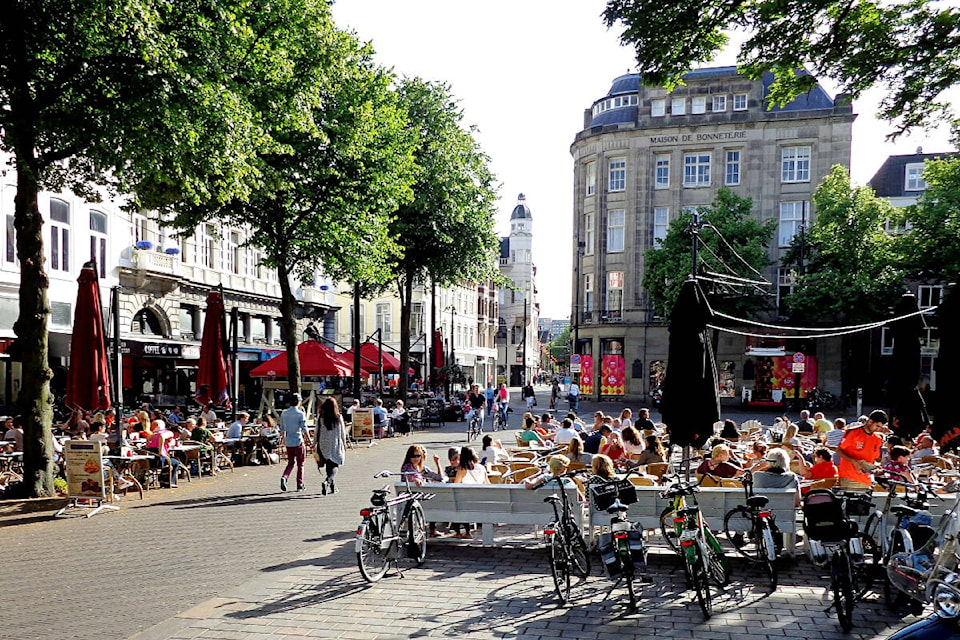Have you heard of the “15-minute city”? If you haven’t, be prepared to hear a lot about the idea in the coming weeks and months.
The phrase “15-minute city” was coined by Carlos Moreno, professor at the Panthéon-Sorbonne in Paris, in 2016. He based the concept on theories that had been around since the 1920s, and envisioned urban spaces where most of the things that people need or want on a regular basis — places of work, homes, shops, schools, sports facilities, parks, community centres — be within a 15-minute walk or cycle ride, as in a traditional town or city.
Basically, the 15-minute city takes things back to the way they used to be (and still are in most small towns), before city centres were hollowed out by the middle classes fleeing to suburbia. That left downtown cores without a lot of services, as those services faced the double-whammy of fewer residents to use them and rapidly increasing rent. Many big city downtowns are classed as “food deserts”, where the remaining residents — often low income people without transportation — have no access to healthy food shopping options, relying instead on convenience and corner stores where items such as fresh fruit and vegetables are either not available or are prohibitively expensive.
So the 15-minute city aims to redress that, by encouraging urban planning and development that makes it easier for people without vehicles to get what they need and want near where they live, and encourages people with vehicles to leave the car behind once in a while and walk to the grocery store, or the rec centre, or work or school. Good for cities, good for people, good for the planet. Win/win/win!
Hold your horses. As proof (if it were needed) that conspiracy theorists can take anything and turn it from a good, practical, common-sense idea into “proof” that we’re heading for a dystopian society that makes George Orwell’s world of 1984 look positively idyllic, the 15-minute city is being held up as a sign that governments are trying to force everyone into “districts” in which we will be forcibly confined. Among the claims being made by some very frothy people are that the 15-minute city will make it easier for governments to “lock down” residents; that electronic gates on key roads will confine people to their neighbourhoods; that if you want to visit a friend or relative in another “district” you will have to ask permission; that surveillance cameras will watch your every move to ensure that you stay in your designated neighbourhood.
Earlier this month, one British MP described the 15-minute city as an “international socialist concept”. Last December, Canadian right wing culture warrior Jordan Peterson coughed up a tweet that read “The idea that idiot tyrannical bureaucrats can decide by fiat where you’re ‘allowed’ to drive is perhaps the worst imaginable perversion of that idea [that neighbourhoods should be walkable], and, make no mistake, it’s part of a well-documented plan.”
Sean Bohle, a senior city planner in Edmonton who likes the idea of the 15-minute city, recently met with protesters opposed to it, to answer their questions and try to allay their fears. I particularly like his response to a question that asked why the plan did not specifically promise never to barricade people into districts: “We didn’t consider that. There are infinite things the plan will not do. We’re not going to neuter your chinchilla, for example.”
That might come off as glib, but no plan in the history of forever has been able to enumerate all the things it won’t do. And the fact is that many of us already live in 15-minute cities, only we don’t call them that; we simply call them the places where we live. Urban planners aren’t out to create a Hunger Games-style world of districts and surveillance and curtailments of our freedoms; they simply want everyone to be able to live in the kind of place a lot of us enjoy right now. In other words, don’t worry about your chinchilla: it’s safe.
editorial@accjournal.ca
Like us on Facebook and follow us on Twitter
